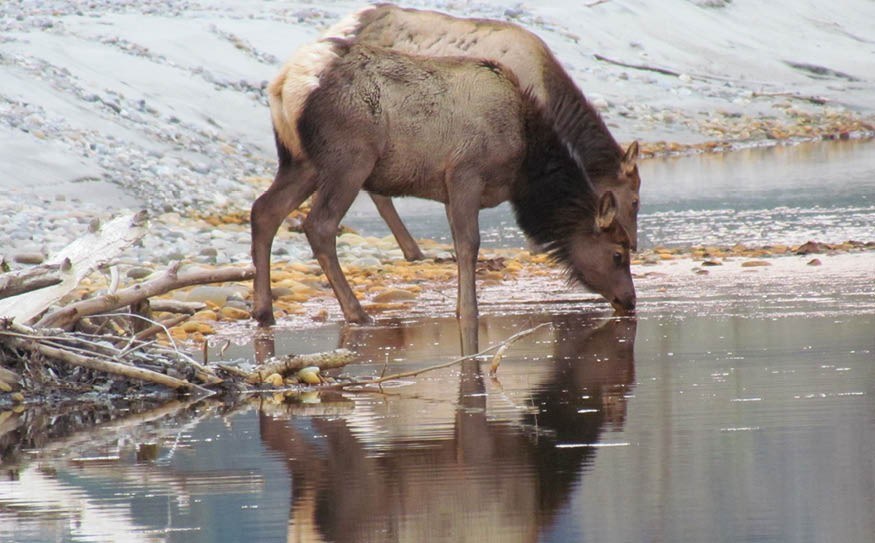Travellers on Highway 99 have been seeing something unique, a natural wonder that just a decade ago was non-existent in the Sea to Sky corridor — elk.
These large ungulates roamed the Mamquam and Squamish River valleys in significant numbers before the 1900s but were wiped out through over hunting within decades of European settlers arriving.
Now, a hundred years later, the majestic animals are once again roaming the landscape.
A key player in the introduction of the Roosevelt elk to the corridor is Darryl Reynolds. The wildlife biologist with the Ministry of Forests, Lands and Natural Resource Operations led a team of experts and volunteers to reintroduce elk. Reynolds established elk populations on the Sunshine Coast then plucked some healthy animals from that population and transplanted them into the wilderness between Whistler and Squamish, and into the Mamquam River valley.
"This is part of a recovery program in cooperation with the Squamish First Nation, the Habitat Conservation Trust Foundation, the province of B.C. and many volunteer groups," said Reynolds of the effort to nurse back wild animals into an area they historically inhabited.
Reynolds estimated that 60 elk are now thriving in the Sea to Sky area after 26 elk were transplanted from the Powell River area in 2006. Another eight elk were relocated from Sechelt in 2011. He said the animals are doing quite well, with a potential to reproduce at a rate of about 20 per cent a year.
"We attach collars to elk when we're relocating them," the scientist said. "Some of the elk are wearing collars still from when they were released. As well, opportunistically, when we're doing our aerial surveys we sometimes dart elk from the helicopter and attach GPS collars to them for future tracking."
The data collected by the collars is very valuable.
"The radio collars will collect GPS locations every three hours for the life of the collar so that will tell us the migration routes of the elk as well as all of their really important habitats," said Reynolds.
The collars allow researchers to understand where the animals feed, where they go to take cover and where they sleep. The data collected by the collar is stored until someone retrieves the collar and downloads the information. Reynolds said getting those collars back is important so anyone who comes across one is encouraged to turn it into any government office.
The biologist noted that he isn't currently on the lookout for any elk collars but he's doing a deer study in the Pemberton area and he's looking for collars associated with a study being conducted between Whistler and Pemberton and up the Pemberton-Lillooet valley.
Mike Wallace, the president of the Squamish Valley Rod and Gun Club, has been follows the wildlife management issue. He believes there are many benefits to re-establishing elk populations. The animals contribute to both tourism and recreation, and, said Wallace, they are amazing to see if anyone is lucky enough to catch sight of them along Highway 99, or in a forest setting.
That proximity to the highway is not without problems. One pregnant elk was killed by a vehicle near the Squamish Adventure Centre last year.
From a hunter's perspective "there's opportunity for hunters to have a limited entry draw on the elk in the Upper Squamish and I guess the other herds in the Indian River and the Mamquam," said Wallace. "That's shared with the First Nations who also get an opportunity for a limited entry hunt."
Squamish Nation environmental advisor Randall Lewis said Squamish Nation members are thrilled by the return of elk to the traditional territory of the Squamish people.
"To have them here in this area, we feel that our ancestors and the Great Spirit are happy to have them back," said Lewis. "We've been getting some exciting biomass back."
Lewis noted that Howe Sound is once again producing herring and the herring is attracting dolphins and whales into Howe Sound.
Environmental advocate John Buchanan is also happy with how the elk are fitting in. He got to witness the release of the eight elk set free near Squamish in 2011. He says it was an honour to watch, as the animals were set free. Video he has captured of the elk on various occasions can be viewed on the Internet.
Meg Toom, the Bear Aware/Wildsafe Program coordinator in Squamish reports that more wolves are being seen and she partially attributes that to the growth of the elk population.
Reynolds said he is well aware of what he calls predation of the elk herd.
However, despite deadly incidents with wolves, cougars, poachers, barbed wire fences and cars the elk population is doing so well that he expects limited-entry hunting opportunities will continue in Squamish well into the future.




